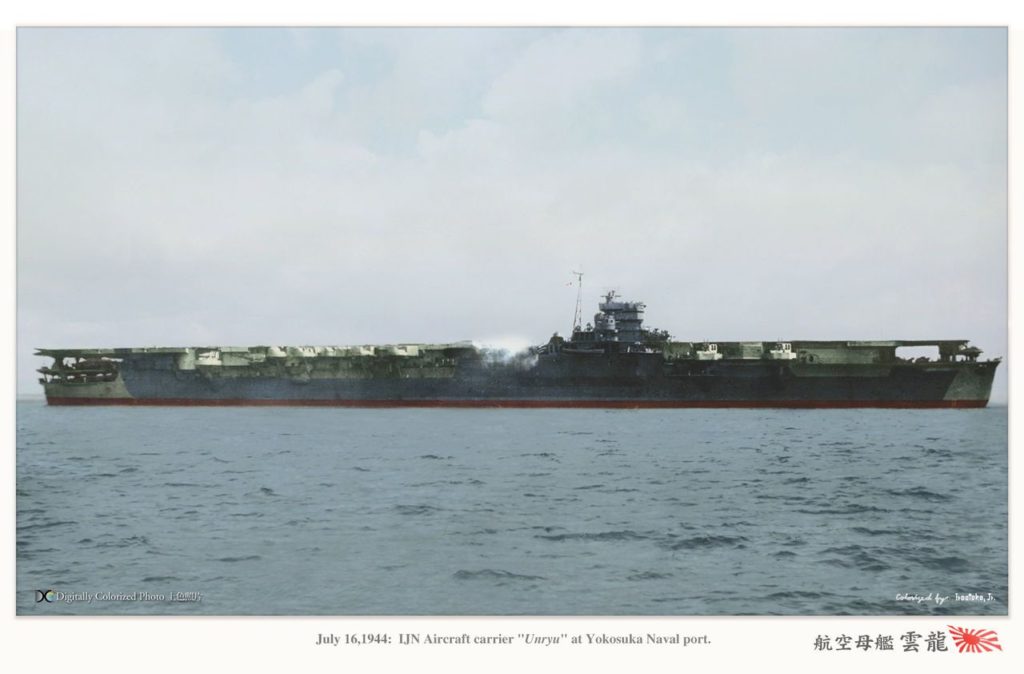
 Japan, 1943-45. 15 fleet aicraft carriers planned
Japan, 1943-45. 15 fleet aicraft carriers plannedIJN Unryū, Amagi, Katsuragi, Kasagi, 5005, Aso, Ikoma, Kurama, Kaimon, 5010-5015.
WW2 IJN Aircraft Carriers:
Hōshō | Akagi | Kaga | Ryūjō | Sōryū | Hiryū | Shōkaku class | Zuihō class | Ryūhō | Hiyo class | Chitose class | Mizuho class* | Taihō | Shinano | Unryū class | Taiyo class | Kaiyo | Shinyo | Ibuki |The Unryū class, last IJN fleet carriers

IJN Unryu in yard trials, Yokosuka, 16 July 1944. The only operational carrier of the whole class (August-December 1944). Colorized by irootoko Jr.
The six Unryū class fleet aircraft carriers were added in the 1942 naval programme, but only two were completed in time before the end of WW2. They saw practically no service. Japanese unprotected, mass-built fleet carrier, they were intended to fill the “second line” role completing clones of the armoured Taiho class. But this plan never realized. The Project was under 1941 the Programme as a modified variant of Soryu, as unprotected “reinforcement carriers” for an all-out decisive naval air battle with the USN. In the end, only two barely entered service before destruction, the rest being scrapped in 1946-47. https://naval-encyclopedia.com/ww2/japan/unryu-class-aircraft-carriers.php #ww2 #IJN #imperialjapanesenavy #japanesenavy #aircraftcarrier #unryu #amagi #katsuragi
Development
The Unryu class was the most ambitious naval program ever carried out by Japan, even by today’s standards. This was in short, the Japanese equivalent to the U.S. Navy Essex class program, albeit at Japanese scale. They were unarmoured and carried less planes, with also only a fraction of the displacement. After all, the whole concept was an attempt to allievate on paper the losses of air groups during a battle. The initial concept was planned early on, with the Maru Kyū Programme (Ship #302 planned in 1941) and the Kai-Maru 5 Programme (#5001–5015 in 1942).
Unlike Shokaku, derived from the Soryu, the Unryu stayed closer to the original concept, with a smaller displacement to be built more easily, simplified and modular for faster construction. With operations commencing in 1942, the design drawn attention of the Japanese naval command, which labelled it as the most eligible for serial construction and thus the class was added in the 1942 program. No less than seven were planned, twice as many armoured carriers in the new tactical reasoning of the admiralty for carrier operations. An additional eight carriers were planned FY1944. However these plans were cut short by the state of the Japanese industry in 1943-44: Only six out of the 15 ordered were laid down in effect, only three were completed, and only perhaps one started fleet operations.
Design of the Unryu class
On general arrangement and architecture, the Unryu class repeated the base design of IJN Soryu, with increased dimensions for the island superstructure, asymmetric hull with a port side deviated from centreline, more than starboard.
Protection
The passive protection scheme was the same as Soryu, and only differed in some details. Underwater protection improved a bit however, with a better compartment arrangement, plus the addition of 50mm (2-in) longitudinal bulkheads in Ducol steel. Magazines had also the same extra layer. Aviation petrol tanks had a double layered plating, but with a concrete layer filling sandwiched. Overall, this was still rather weak.
Detailed Ship protection:
Main Belt: 46mm (1.8-in) protecting machinery spaced
Lower hangar Belt connection to the upper edge of its deck 25mm (1-in)
Magazines and avgas tanks 55mm (2.1-in) roof plating.
Magazines 165mm (6.5-in) side protection.
Longitudinal anti-torpedo bulkhead: 50mm (2-in) thick.
Avgas Tanks Additional concrete protection.
As for active fire-fighting protection and capabilities, it seems the Soryu scheme was repeated, comprising a partition of both hangars in three fire-fighting areas, flexible curtains, sprinklers, and at least a core dedicated team. However it was probably lower than on the Shokaku class, or even the Taiho class for that matter, given their second line role. Whatever the case, this was never demonstrated in operation. Flooding control was unable to prevent the sinking of IJN Unryu for example, not helped by her average ASW passive protection anyway. Soryu’s fire-fighting capabilities failed but largely because at Midway her hangar crews were caught refuelling planes when bombs fell.

IJN Katsuragi on sea trials off Cape Sata offing, October 1944. Colorized by Irootoko Jr.
Powerplant
Machinery was a repeat of the Soryu and Hiryu. It was based on the standard machinery of the heavy cruiser IJN Suzuya.
Shortage of turbines forced to use those from Katsuragi and Aso, which were destroyers. The output was as a result 1/3 lower and speed fell from 2 knots.
Thus powerplant thus was composed of four shafts driven by four geared steam turbine sets, one for each, and each in turn by two (total eight) Kampon water-tube boilers.
Installed power thus amounted to 152,000 shp (113,000 kW) for a still comfortable top speed of 34 knots. As for autonomy, the lead ship, IJN Unryu carried 3,670 tonnes of heavy crude oil for an overall range of 8,000 nautical miles at 18 knots.
This was different for her sisters:
Unryū built by Yokosuka Naval Arsenal had the exact same “surplus” boilers and turbines as the heavy cruiser Suzuya.
Amagi and Kasagi built by Mitsubishi in Nagasaki however had surplus stock of the Ibuki-class cruiser machinery. They still stayed comparable.
IJN Katsuragi and Aso from Kure Naval Arsenal however by the time they were to be equipped with machinery, had “what was available”, two sets of the Kagerō-class destroyer machinery. They were much smaller, ans thus, freed space was used by extra fuel tanks, making for the speed loss in autonomy.
Unryu, Amagi, Kasagi, Ikoma were all rated for 152,000 shp, whereas the destroyer-powered Katsuragi and Aso went down to 104,000 shp. Therefore they went from 34 to 32 knot top speed, although still rated for a 3,670-3,800 oil tons bunkerage, enough for 8000 to 8500 nm at 18 knots. Katsuragi confirmed this by her sea trials.
Armament
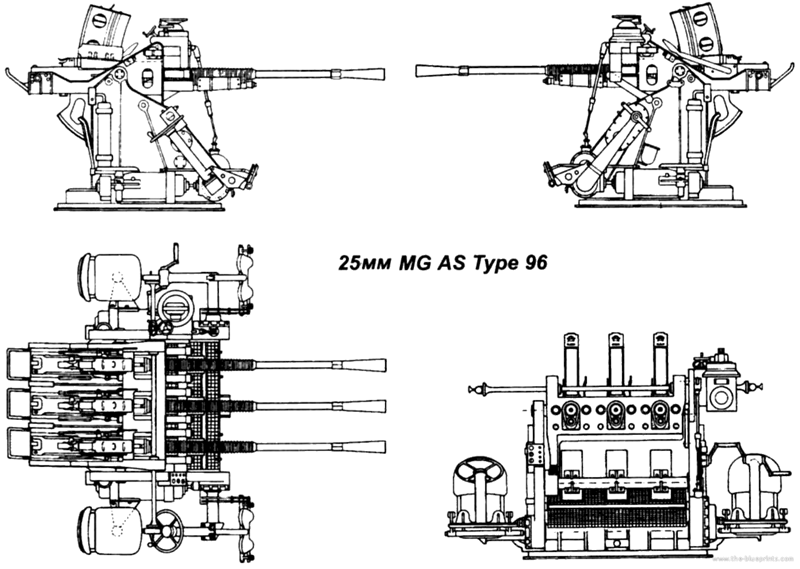
IJN standard 25 mm Type 96 triple mount.
As initially planned in early 1944, IJN Unryu was to be armed with the same, just augmented armament of IJN Soryu: Six twin 127mm/40 (5-in) Type 89, in two pairs forward of the bridge and fore lift, symmetrical but as usual sponsoned under the deck level, and two aft ones, located either side of the hangar. They were unable to support crossing fire above the deck unlike USN practice.
This was completed by “only” twenty-one triple 25mm/60 Type 96 AA guns, so 63.
For IJN Amagi and Katsuragi this was a bit different as they had the same six DP 5-in mounts, but 22 triple Type 96 plus 23 single ones.
Total provision of 25mm AA guns went to 93 total in combined triple/single mounts, plus 180 AA rockets between six 30-tubes launchers in the end. The Rate of fire of the Type 96 was 200–260 rpm (cyclic) with a mv 820 m/s (2,700 ft/s) and effective range below 6.8 km (4.2 mi) at 45°. It’s major issue was its Feed system using 15-round box magazine. The Type 96 was based on the French Hotchkiss 25 mm AA gun.
See the Type 96 25mm Gun in detail.
But they differed when commissioned, as probably the admiralty had doubts in 1944 about the efficience of their traditional AA guns, and pressed instead for the adoption of a new weapons system better suite to bring massive firepower on incoming attackers: The 5-in (127mm) 28-barrel Type 02 AARL.
See more on the gunnery section and on navweaps. Unryu was to have six of them, probably replacing six triple 25mm Mounts, locations unknown. In 1944-1945 Unryu and Amagi received six 28-tubes 120mm AA Rocket Launchers and Katsuragi eight.
These ships were also relatively autonomous for ASW protection, now seen as a genuine threat in 1944, in addition to their built-in hydrophone and sonar, they carried 30 depth charges. Their Ki-76 aircraft were especially tasked of ASW patrol, not being armed themselves, they vectored in escorting destroyers.
Sensors
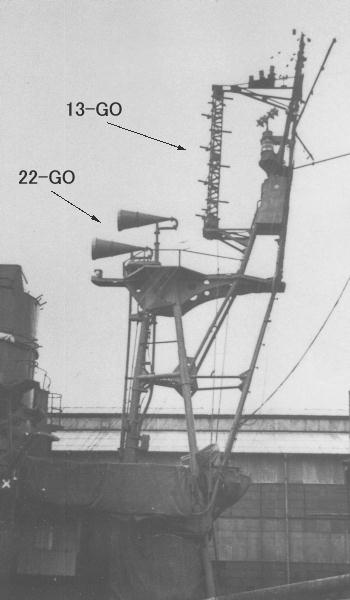 Being completed in 1944, the carriers were of course provided radars. Each ship was to carry two 1-shiki (Type 1) 2-go (Mk.2) radars, placed and a single 3-shiki (Type 3, Mk.1) 1-go radar on top of the bridge, for aerial warning. But this varied between ships:
Being completed in 1944, the carriers were of course provided radars. Each ship was to carry two 1-shiki (Type 1) 2-go (Mk.2) radars, placed and a single 3-shiki (Type 3, Mk.1) 1-go radar on top of the bridge, for aerial warning. But this varied between ships:
Unryu: 2× Type 21 radars (top of island and flight deck), one Type 13 radar (mast)
Katsuragi: 2× Type 21 radars (top of island and flight deck), 2× Type 13 radars (mast and radio antenna)
Amagi (and Katsuragi 1945): One Type 21 radar (flight deck), one Type 22 radar (top of island), one Type 13 radar (mast).
Type 0 hydrophone, Type 3 active sonar (Unryu and Katsuragi), or Type 93 hydrophone, Type 3 active sonar (Amagi Only)
The Type 21 radar was obsolete in late 1944. It operated at 200-MHz (1.5 meters) wavelength (Like the RN Type 286M or USN CXAM of 1940). These were air warning radars only capable of detecting a large bomber formation at circa 60 nm/100 km aircraft group, but had very wide beams of +/- 60 degrees.
The Type 13 Radar air-defense radar was introduced in 1943 and also tailored to spot large groups of aircraft at up to 100 kilometers or single aircraft at 50 km. Combining a matress and dipoles, it worked at 200 cm, pwd 10 microsecond, PRep. Freq. 500 Hz, Pw 10 kW.
Air Facilities
The Unryu class were tailored for reinforcement, not for air operation themselves originally, which in part explained why they had no catapult and two lifts only. Using a full load of deck aircraft for a one-go launch was probably the way they should he been used in operations.
Flight deck: It was relatively generous, at 5,856 (63,000 Sq.ft) or 5,792m² (62,300 Sq.ft) respectively for Unryu and the next two ships. The flight deck measured 216.9 meters (712 ft) on Unryu, 214.5 meters (704 ft) on Katsuragi, Aso but the same 27 meters wide (88 ft).
Hangar: 6,405m² (69,000 sq.ft) and roughly 32,000m³ (1,130,000 Cu.ft) in volume with the upper hangar measuring 175 x 21m (574 x 69 ft) and lower hangar 130 x 21 m (426 x 69 ft).
Lifts: Same size fore and aft, 8-faceted, 15 x 14 meters (49 x 46 ft) and a 6.5t capacity (13.000 Ibs).
Aircraft fuel stowage was 216,000 liters total. The avgas tanks were buried deep into the hull for safety. As customary refill operations were done in the hangar.
About ammunition storage and capacity: 72x 800kg bombs, 240x 250kg bombs, 360x 60kg bombs, 36x Type 91 Mod.6 aerial torpedoes (6 torpedoes could be handled at the same time) were carried.
Main ammo storage rooms were placed below the main armour deck (lower hangar deck) for extra protection, with lifts communicating to the lower and upper hangars. The lower hangar was used more for long term maintenance and as workshop, the upper one for combat preparation. The relatively light and small cruiser (or even destroyer) machinery adopted enabled to lower the lower hangar deck to waterline level almost, ensuring the whole ships kept a low profile. It’s quite striking when comparing them to the Ark Royal for example.
Air Group 601

Yokosuka D4Y4 Model 43 ‘Suisei’ (the radial engine version) from 601 Kokutai, used as Kamikaze at Okinawa in 1945, notice the rear fuselage belly lodging for additional propulsion rockets.
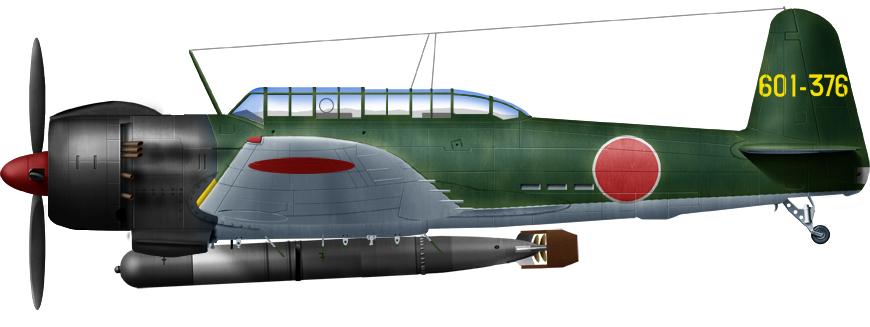
B6N Tenzan “Jill” of 601 Kokutai, also assigned to Shinano (which received priority over the Unryu class).
Planned in 1943 to be fourteen A6M2, 21 D4Y1 and 20 D4Y1C, the “Judy” was usable both for dive bombing and reconnaissance. But on paper hey were to carry a variation of the A6M fighters, D3A, D4Y diving bombers, B5N, B6N, B7A torpedo bombers, C6N recon planes.
In reality by the fall of 1944 before her loss, IJN Unryu carried only 56 A6M5 Zero fighter-bombers and four Kokusai Ki-76 for reconnaissance, liaison and ASW patrol.
However for her first mission before her loss, she was to carry Air Group 601, but this was replaced by a load of “Okha” kamikaze missiles, and 1,500 tonnes and cargo and personal between her flight deck and hangars. It looked like this.
Katsuragi’s air group on paper varied considerably also: In 1942 when laid down, she was to have 12 A6M3 Zero (3 storage), 27 D3A Val (3 reserve), 18 B5N “Kate” (2 in crates) with 11 to be permanently carried on the flight deck. In 1943 this was 18 A7M “Sam” fighters (+2 storage), 27 D4Y “Judy”, 6 Nakajima C6N “Myrt”, one on flight deck. When commissioned this was 27 Zeros, 12 D4Ys,(3 of the C reconnaissance version), 9 B6N “Jill”.
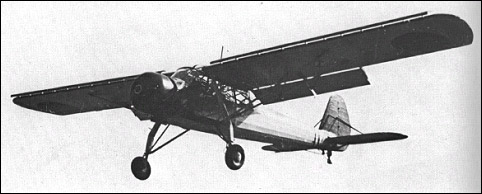
Kokusai Ki-76, a Japanese replica of the German Fieseler Storch. Its main advantage was to be near-STOVL, taking off and landing from any carrier, large or small.
Her two sister Katsuragi and Amagi also shared Air Group 601. The 601st Naval Air Group (Dai Roku-Maru-Hito Kaigun Kōkūtai) was probably the very last IJN carrier air group, later converted to airbase garrison unit in the Pacific campaign and of WW2. Created on February 15, 1944, it was assigned to the 3rd Fleet (15 February 1944–9 July 1944), 1st Carrier Division (10 July 1944–9 February 1945)
and 3rd Air Fleet (10 February 1945–postwar). It comprised in theory twice the 65 planes intended for Katsuragi and Amagi, plus spares, of many types: The 161st, 162nd, 308th, 310th, 402nd Fighter Squadron with the A6M5 Zero, and 1st, 161st, 254th, 262nd Attack Squadrons with a mix of models, D4Y “Judy” and B6N “Jill”, as well as the 61st Reconnaissance Squadron with the Ki-76 or C6N Saiun. The air group never operated from the Unryu class carriers apart for limited training, mostly done at a land base, and the ship only acted as “taxis”. They did however took part in actions from Zuikaku, Shokaku and Taiho, at the Battle of the Philippine Sea, reconstituted later to take part in the Battle of Iwo Jima and Okinawa as Kamikaze units, and the remainder in the defence of Japan.
The Ikoma sub-class (1943)
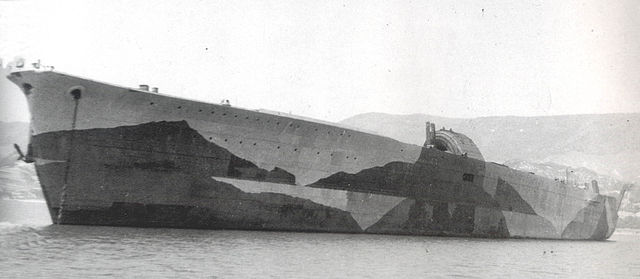
IJN Ikoma, never completed, but the most advanced of the sub-class.
The Ikoma sub-class was a simplified version to accelerate construction, so everything that can be omitted or be made simpler to manufacture on the Unryū class was adopted. Part of the Japanese engineer’s effort went into their machinery: The Ikoma class were equipped with shift-arrangement machinery, four sets of parallel boilers and one turbine. The funnels were intended to be more spaced out as a result, which was the most critical giveaway of the design. Unofficial designation for the IJN became “Modified Ship Number 302-class” or Kai Dai 302-Gōkan-gata.
All in all, nine ships were planned, hull number 5007 to 5015. The only named were IJN Ikoma (5007) and Kurama (5008). Both were launched but never completed. It should be noted that the dates advanved for completion of the last ships, 1947 and even 1948 meant construction time still of three years, whereas some Essex class were planned to be built in just two.
In an alternate history scenario where the US lost all their remaining carriers at Midway, enabling Japan to force peace negociations and the US to focus on the European theater, the class could have been built perhaps ealier (courtesy of the absence of US submarine in the wholesale destruction of materials to Japan), and the grand plan of perhaps eight Taiho-class armoured carriers and double that in unarmoured Unryu type carriers, the “Kido Butai” 2.0 would have been probably unbeatable, or very tough opposition to overcome. Even facing 8 Essex class carriers in 1945 if the US went back against Japan at the time.
Appearance

Author’s old illustration of Unryu

Schematics of the camouflage sported by IJN Unryu (src unknown, via imgurl). These carriers all received the 1944-45 bi-tone green camouflage, outer hull section in pale olive, and amidship waterline scheme dark olive roughly imitating the outline of a cargo. The deck was as usual more complicated, with a three tone broken lines pattern (WW1 style) of dark olive green, dark sand and black. The usual deck markings were kept, with the vector fan forward, deck lines, and landing approach red-white banner.
⚙ Specs Unryu 1945 |
|
| Dimensions | 227.4 oa x 22.0 wl (27.0 fd) x 7.85 m |
| Displacement | 17,150 t. standard -22,400 t. Full Load |
| Propulsion | 4 Kampon geared steam turbines, 8 Kampon boilers, 152,000 hp. |
| Speed | 34 knots (62 km/h; 40 mph) |
| Range | 8,000 nmi (14,350 km; 8,920 mi) at 18 knots (33 kph, 21 mph) |
| Armor | Belt 46mm (165 abreast magazines), lower hangar deck: 25mm (56 over magazines) |
| Armament | 6×2 127mm/40 Type 89, 21×3 25mm/60 Type 96 AA, 64-65 aircraft |
| Crew | 2400 |
Sources/ Read more

Books
Conway’s all the worlds fighting ships 1922-1947
Lengerer, Hans (2010). Illustrated Record of the Transition of the Superstructures of BB Kongô Class: Introduction to CV Unryû Class. Model Hobby.
Stille, Mark (2005). Imperial Japanese Navy Aircraft Carriers, 1921 – 45. New Vanguard. Osprey
Worth, Richard (2001). Fleets of World War II. Da Capo Press.
Shizuo Fukui, “Stories of Japanese aircraft carriers”, Kōjinsha (Japan) August 1996
Rekishi Gunzō “Perfect guide, The aircraft carriers of the Imperial Japanese Navy & Army”, Gakken April 2003
Daiji Katagiri, Ship Name Chronicles of the Imperial Japanese Navy Combined Fleet, Kōjinsha 1988
“Japan Center for Asian Historical Records”., National Archives of Japan
Monthly Ships of the World, “Kaijinsha” No. 481 and No. 736, Special issue 2011
Maru Special, Ushio Shobo Warship Mechanism Vol. 3, “Mechanisms of Japanese 29 Aircraft Carriers” August 1981
Japanese Naval Vessels No. 23, “Japanese aircraft carriers I” January 1979
Senshi Sōsho, Asagumo Simbun Vol. 31, Vol. 88 1975
Japanese Aircraft Carrier Unryu Class (ModelArt) Vessel Model Special No. 46
Sōryū, Hiryū, and Unryū-Class Aircraft Carriers: In the Imperial Japanese Navy during World War II (Legends of Warfare: Naval, 17) Hardcover November 28, 2020
Links
combinedfleet.com/ unryu class
on historyofwar.org/
hazegray.org/ UJN CVs
IJN Radars on pacwar encyclopedia
IJN radars on secretprojects.co.uk/
Some footage and also
Unryu TROM on combinedfleet.com
Videos
The model’s corner


Artist impressions.
Main query on scalemates.
Lack of choice, mostly Japanese brands: Aoshima, Fujimi, and Pit-Road, all 1:700.
Career of the Unryu class
 IJN Unryu
IJN Unryu
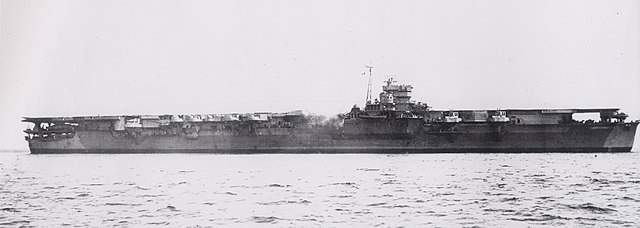
IJN Unryū (雲龍) was laid down at Yokosuka Naval Arsenal as ship #302 on 1 August 1942. She was launched on 25 September 1943 and completed on 6 August 1944, early enough to see some service.
After commission on 6 August 1944, she was assigned to the 3rd Fleet and performed her short shakedown cruiser and trials in the safety of Tokyo Bay through mid-September 1944. Only then she was transferred to Kure Naval District, and from there made many training runs around the Seto Inland Sea, until December 1944.
Pre-Operational Sorties
on 10 August 1944, she was assigned tactically to 7th Base Air Force Air Attack Force (3rd Air Fleet) but remained in CarDiv 1, 3rd Fleet. After her trial runs off Yokosuka, she multiplied short one day sorties in Tokyo Bay region. On 26 September she departed for Kure escorted by the DDs FUYUZUKI and SHIMOTSUKI, departing on the 30th for her shakedown in the Inland Sea and on 1st Ocorber October stopped at Hashirajima, departing the following day for Matsuyama, departing on the 6th for Yashiro-jima, then Yashima and ten days after, returned to Kure for fitting out. On the 28th she departed to join IJN AMAGI at Gunchu-koh (Gunchu Bight) and two days later receiving the flag of Vice-admiral Jisaburo Ozawa of the Mobile Fleet, saved from IJN HYUGA. She became essentially flagship of the Mobile Fleet, the most important Japanese combat unit.
On 6 November 1944 she left Kure and later Ozawa transferred his flag to IJN RYUHO. Both were assigned for emergency transport operations to Luzon. On 12 November she is prepared for her first sortie in Kure, three days later the Mobile Fleet is abolished and she is reorganized as part of the Combined Fleet’s CarDiv 1. On the 27th, she departs Kure for Gunchu Bight and on 7 December she is ready for her first emergency reinforcement mission bound for Luzon, returning to Kure for loading her payload. She embarks notably some A6Ms and B6Ns. This suppose still no pilot qualifications to that point, so no capable air group aboard.
Operations
On 13 December 1944 as a large Allied invasion fleet was spotted in the Sulu Sea believed to head for Luzon, UNRYU and RYUHO, the sole CarDiv 1 operational carriers are ordered to load “Ohka” (USN Intel “Baka”) suicide rockets to be carried to Manila. UNRYU took thirty aboard and RYUHO followed after being prepared. UNRYU was to leavve Kure on 16 December. At 1200 JN Sigigure arrived to join her escort. Learning about the landing at Mindoro and not Luzon, departure is rescheduled for the 17th.
The following day, are loaded-pack on her flight deck Daihatsu barges, trucks and field pieces plus 30 Ohka secured in the forward lower hangar deck, but with their warheads already attached. Support personnel and ground forces of the 1st Glider Regiment accompanied them, intended as infantry reinforcements. All this became the 1st Raiding Group HQ, 1st Glider Regiment with a Mountain Gun Company, 1st Engineer Raiding company, 1st Raiding Signal Unit company, and the 1st Glider Regiment’s ground crew plus civilian employees for a total of perhaps 200. Designated Air Group 601, the unit aboard Unryu, was not present for this trip. So apart 1,500 tons of cargo, she had no aicraft defense but her own armament.
On 17 December 1944 at 08:30 Unryu departed Kure at last with Shigure as only escort, but reinforced soon by Desdiv 52’s old HINOKI and MOMI. This force named Comdesdiv 52 was assigned to convoy defense under command of the carrier’s Captain Konishi Kaname, ordered to proceed to Manila via Mako (19), expected to arrive on 21 or 22 December. After unloading cargo she was to report to VADM Shima Kiyohide (2nd Striking Force command) for furher instructions. After halting at Shimonoseki Strait mouth for the morning tide she proceeded as planned, at 06:30 went through Shimonoseki Strait, the headed SW along the Korean coast, NE of Saishu Islands, trying to avoid a typhoon slow her down.
http://www.combinedfleet.com/unryut.htm
Loss
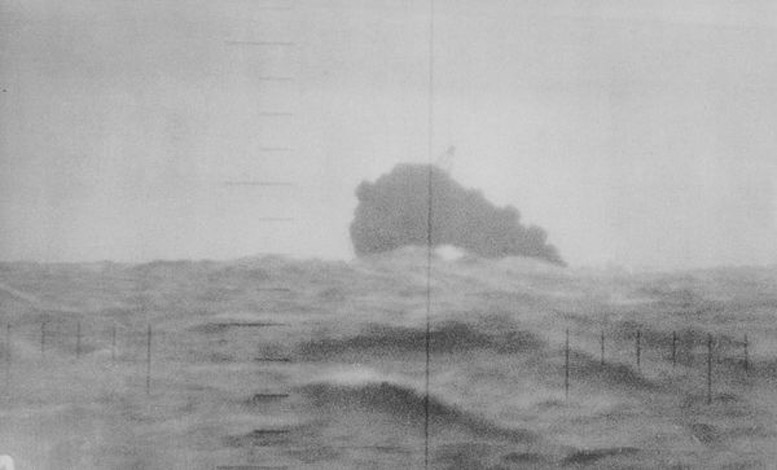
Unryū sinking, December 19, 1944. Photo taken through the periscope of Redfish.
Her maiden sea voyage and first operational mission, was a desperate attempt to reinforce Luzon’s forces prior to the Allied landings. But this proved her last. As so many IJN carriers and warship at large, she fell prey to the total inadequacy of Japanese ASW preparations befor the war. With just three destroyers in the screen and rare escort patrols nearby, she was now a prize target for US sub commanders that precisely new the precise routes of the IJN fleet and could easily predict nect moves.
On this 19 December 1944 at 16:35 as Unryu was steaming 200 nautical miles southeast of Shanghai, East China Sea, she was hit by a single torpedo under the island, starboard side. It was scored by ambushing U.S. submarine REDFISH. The torpedo hit abreast the forward generator room (Hold Deck) also knowing off the Main Control Center at No.2 platform deck (frame 98, close to the bulkhead aft). No.1 boiler room was rapidly flooded and single the bulkhead failed in between, port No.2 boiler room also flooded, and in general all boilers lost pressure (except N°8).
The main steam line was fractured.
The carrier as such lost power, went dead in the water while a fire broke out, in No.2 ready room. The team reacted and closed firewalls foertunately. However, USS Redfosh was not done yet. The bow torpedo spread has been spent, the stern ones as well, but its captain tried to have the latter reloaded at 16:42, trying to hit IJN Hinoki in escort. Meanwhile, Chief Engineer Capt. Saga Tetsuo’s engineers of the safety team managed to have all fired extinguished and recuperated 5, 6, and 7 boilers. They also patched damaged pipes, managing to restore power whereas all three destroyers were in a hot pursuit of the submarine, unable to locate her yet.
Suddenly at 16:50 just as Unryu had resored enough power to get underway, she was hit by second torpedo starboard, forward of the bridge, dangerously close to the bomb and torpedo magazines. This was the coup de grace. Indeed, the blast was enough by the concussion to detonate ordnance, rapidly extended to the cargo of Ohkas, fully loaded, in the lower hangar deck; This all turned into an instant inferno, blewing her bow off and wrecking the ship into a serie of devastating explosions. There was no recovery from this. UNRYU took a massive flood, started to rapidly list to
30° starboard and practically as it happened, Captain Kaname did not lost time and ordered to Abandon Ship. Unryu sank in about seven to ten minutes at 29°59′N 124°03′E, which was short for such internal buoyancy, another indice of the gravity of her state.
At circa 17:00 she sank, stern up, practically full starboard. Her captain, captain Konishi Kaname, XO Capt. Aoki Tamon, Navigator LtCdr. Shinbori Masao and 60 officers, 1,172 ratings went with her. A few survivors were picked up by the remaining destroyer Momi, HINOKI and SHIGURE now sure of the location of Redfish, went after her with depth-charges.
About 88 survivors (8 injured), 57 passengers, one civilian employee survived on 146 total. On the 20th, the destroyers left the area, unable to spot other survivors. Momi and Hinoki went back to Takao, Japan while Shigure remained behind to hunt REDFISH. As it happened often, USS Redfish (SS-395) a Balao-class, escaped and returned home to a hero’s welcome. After GUPPY modernization she served until 1968. She also almost sank IJN Junyo and earned a Presidential Unit Citation for her only two war patrols.
Unryu was stricken from the navy list on 20 February 1945.
 IJN Katsuragi
IJN Katsuragi
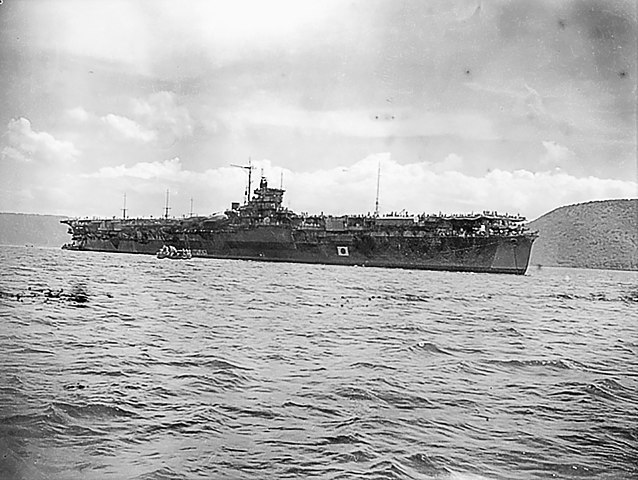
On 15 October 1944 IJN Katsuragi started her official sea trials, and was commissionned, assigned to CarDiv 1 (Firts Carrier Division) of the Mobile Fleet under command of Captain Kawabatu Masahru.
Until December 1944 she stayed in the Inland Sea training with little fuel available, and moving between Gunchu, Kure, and Hashirajima.
On 28 October she trained with UNRYU off Gunchu-koh and by 15 November south of Goto Island she was spotted by USS Barb and USS Queenfish with three other ships underway to the north. It was likely however JUNYO, TONE and escorting destroyers. BARB attacked, claimed to have hit SHINYO but this proved false. Two days later, Katsuragi trained with IJN AMAGI in the Inland Sea and on 10 December Rear Admiral Keizo Komura at the head of the division was replaced by Sueo Obayashi. On the 12th, Both Katsuragi and Amagi stopped at Matsuyuma roadstead and was ordered on the 21 to be prepared for a transmoirt mission with the Oita Detachement, Yokosuka Air Group (in Kure). She was to received her Air Group comprising B7As for torpedo attack training.
On 23 January 1945 Katsuragi left Kure for Iwakuni and back on 4 February. On the 10th she becam flagship of the newly created division (RAdm Obayashi) while CarDiv 1 was cancelled and she was attached to Combined Fleet.
On the 15th she was back at Kure with Amagi. It was now two month after the loss of Unryu, and no hope to have four carriers of the class as the core of a new task force. It decided instead to land their assigned Air Group 601 for a desperate counter-attack at Iwo-Jima. It seems from there both Amagi and Katsuragi were ordered camouflaged. Katsuragi even had false sheds on the flight deck and trees installed on the upon the island.
On the 19th while Air Group 601 was “spent” in a kamikaze attack one Iwo Jima (possibly sank USS BISMARCK SEA, damaged USS SARATOGA), Katsuragi stayed on the roadstead.
On 19 March however in the morning TF 58 launched a massive air raid. She had a close-call to her starboard bow, but the near hit blew a 5-ft diameter hole in her upper plating; Shrapnel made quite some damage as well. Likely more Zuni rockets hit her, another on her after port side, flight deck, but the damage was repaired faster. She had also her air compressor room flooded and on fuel tank contaminated with seawater.
On the 24th she was ordered to hid at Mitsuko-jima and haff-decommissioned. She received an even more extended camouflage work. On 1st April, Captain Hiratsuka Shiro took command and four ays later her personal was sent to IJN YAMATO. On the 13th she was joined by Amagi at Mitsuko-jima also camouflagd extensively.
On the 20th she became a “special duty” reserve ship (4th Kure Naval District) with Captain Miyazaki Toshio taking command. Until July 1945 she kept this mooring. She was completely draped by camoufage nets and renewed foliage above, false “trees”, false “houses” and even sand to create fake roads as if she was an extension of the island. The captain only commanded to her AA battery crews, ready for action.
On 3 July she was re-assigned to Combined Fleet Defense Naval Force and on 24 July was attacked more seriously by TF 38. She escape the fat of Amagi, prime target this day. She was attacked by 10-12 SB2C Helldiver dive-bombers but they were repelled bt Gunnery Officer Hoashi, apart a single 500 Ibs bomb hit on one port side 5-in battery. The 13 man gun was killed, 5 injured, but damage was minimal.
On the 28th however if Amagi took the brunt of the attack, Katsuragi this time was not spared. She received a 2000 Ibs AP bomb direct hit through her flight deck from starboard behind the island, skidded inside and detonated in the enclosed hangar, the blast blasted by 20-ft the port hangar wall and bulged the flight deck between elevators. Both elevators became jammed up while the hangar was deformed and perforated, her bridge damaged bt shrapnel. Captain Izumi Fukujiro and most officers were killed, 12 wounded. But the ship remained seaworthy. The war ended without another attack.
Postwar: On 10 September 1945 she was versed to the 4th Reserve Fleet, and the 25th prepared for a sortie, on 2 October as “Special Transport Ship” under Captain Miyazaki Toshio moving to Kure and started preparation for her first repatriation trip with a crew of under 50 men.
Inspections led to some repairs in drydock and she was prepared to carry 5,000 men in her hangars. She departed on 18 December for Minami-Daito-jima, Rabaul, and back for durther repairs for rain protection until 15 January 1946. She sailed to Wewak, Rabaul in February and more trips with troops and refugees, about 12,000. By April 1946 she was anchored at Kurihama, stricken on 15 November and on 22 December prepared for scrapping at Sakurajima Hitachi Zosen (Osaka) completed by 30 November 1947.
 IJN Amagi
IJN Amagi
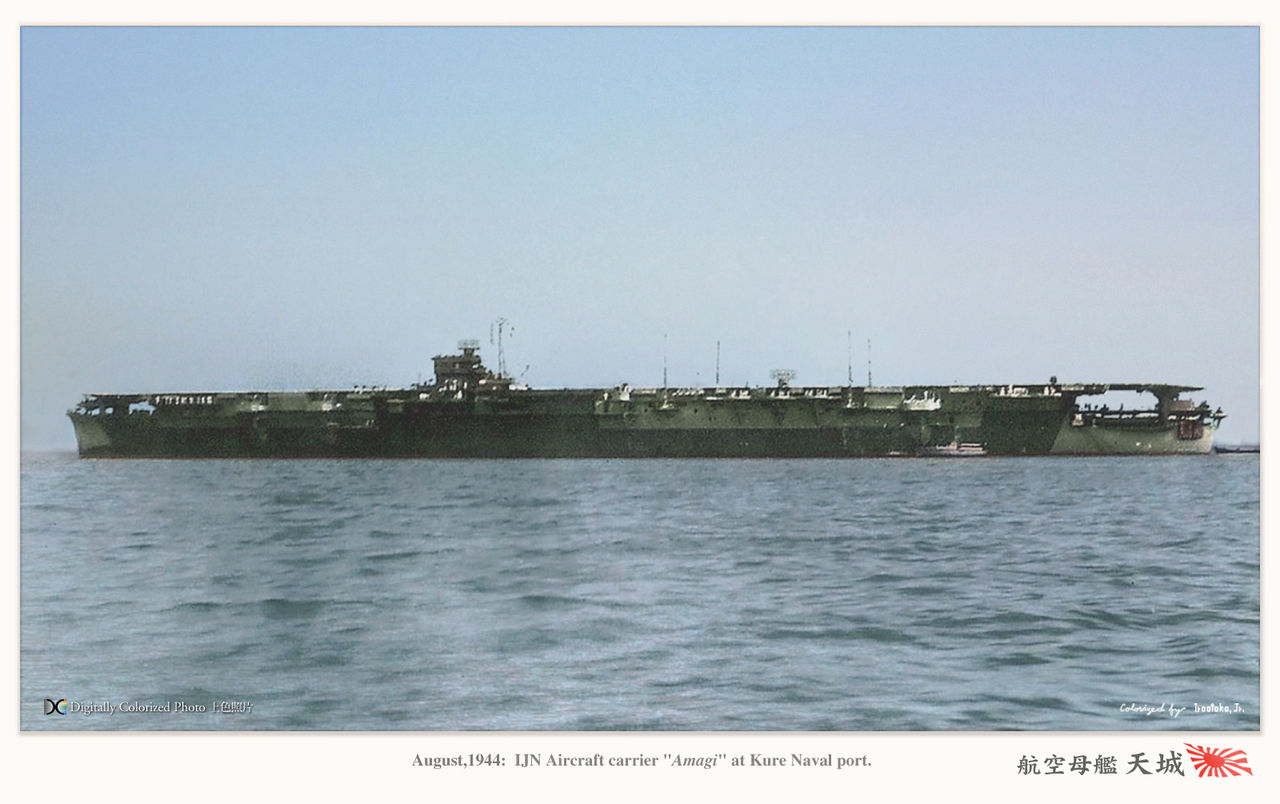
IJN Amagi in Kure, August 1944.
Amagi, laod down at Mitsubishi-Nagasaki Shipyard on 1st October 1942 and launched on 15 October 1943 was completed on 10 August 1944, a few days after Unryu. She became the third “operational” carrier of the class, even if like the others, she never had a proper air group nor participated in a regular mission. Instead like her sister Katsuragi she spent time in a semi-reserve, heavily camouflaged near a small island and experiencing fierce air raids.
Her first CO was Captain Yamamori Kamenosuke as she was assigned to Mobile Force, CarDiv 1, Third Fleet. After sea trials and commission she moved to Oita as flagship of Vice Admiral Ozawa Jisaburo’s Mobile Fleet. By December 1944 she strayed training with full complement in the Inland Sea between Gunchu, Kure, and Hashirajima. She proceeded to air groups qualifications from Matsuyuma air base. On 23 October 1944 Captain Miyazaki Toshio taked command.
She trained with UNRYU off Gunchu-koh notably while later their unit was commanded by Radm Sueo Obayashi. On 20 December 1944 she was his flagship for the newly created ComCarDiv 1 and went on in torpedo attack training exercises, as a target for land-based B7As.
Since she only had fuel to stay at 12 kts, until 20 January 1945 she moved littled. Air Group 601 which was assigned to her and Amagi was re-assigned to Iwakuni Air Base, carried by Amagi. On the 21th at Iwakuni she was ordered to carry the Oita Detachement (Yokosuka Air Group) from Kure to Iwakuni. On 10 February 1945 she is docked at Kure and received her air group, to be reassigned to air bases in Kyushu. On 15 March she is reassigned to 2nd Fleet and on the 19th she is attacked by TF 58 at Kure, while anchored northwest of IJN Haruna. Her flight deck edge is hit by 250/500 Ib bombs starboard aft, which among other jammed her aft elevator down position, but her unners claimed 12 shot down.
On 26 March she moved to the drydock for repair and refit at Kure but Katsuragu went before, later sent to Mitsuko-jima Island. After operation Ten-Go (2nd Fleet wiped out) the naval staff decided it was no longer time for grand operations and Amagi was sent to join her sister at Mitsuko-jima for deactivation. She arrived on 13 April and was heavily camouflaged, turning as “special duty” ship with reduced crew (AA gunners mostly) for the 4th Kure Naval District under Captain Shiro Hiratsuka, but surpervising both carriers.
She would share the fate of Tatsuragi: Until July 1945 her mooring was just 50 m offshore, southwest of Mitsuko-jima Island (Kure harbor), “blended” into the island like her sister. But on the 24th, TF 38 unleashed hell at at 07:45. First wave had her near-missed. One left her with a hole in the hull 15 feet below the waterline, flooding the fwd bomb magazine and causing some list to port. The second wave meant two direct hits in her starboard passageway, blewing her stack and holing her starboard hull. But the second was a 2,000 Ib bomb which struck in the hangar between the elevators. The blast blew the hangar walls and flight deck, jamming the two lifts for good. The deck was bulged over 200 feet, sides blown out. sky. A third hit miraculously spared the bridge. Other near-missed holed her waterline following her Boiler Rooms 4 and 6, port side and she started to sink.
Next waves dealt her more 5-inch rocket hits. The Design Superitendent of Kure NyD stated she was at no reisk of sinking completely though. Controversial order to abandon ship was given later. She was attacked again at 15:30 but she remained still afloat but more flooding to starboard balanced her sinking.
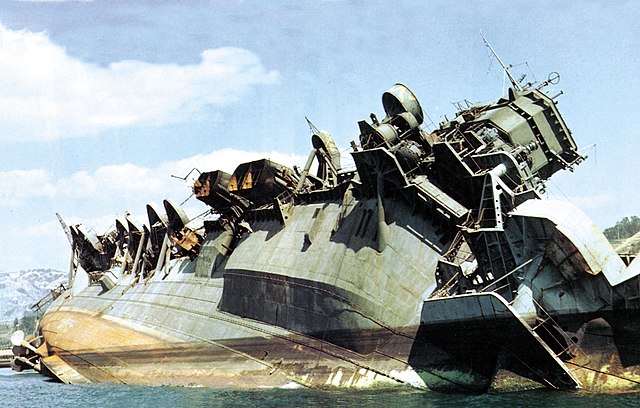
IJN Amagi capsized in Kure, 1946
However she was to receive the coup de grace on 28 July 1945 stariting at 09:30, targeted by 30 planes with bombs and rockets. She claimed one, since her crew and AA gunners has returned.
Ayt midd-way she was bombed from altitude 11 B-24s, taking near-misses, holing the waterline. She took two direct hits and many near-misses to port. Last straw was at 15:30. Hammered by rockets, her flight deck was completed shattered. At 16:00 her starboard list, abandoned again, she had progressive flooding. It went on and on 29 July she slid into the sea, heeling at 80° but capsized, toppling over, grounding at 70° with her starboard screws exposed. Inspected on 13 October she was written off on 30 November.
Podtwar, she was raised from 16 February 1946 for scrapping authorized at Harima Zosen Yard in Kure, starting in November-December. The tremedous work ended only by 31 July 1947 afloat with poontoons attached, hauled to the Navy Yard for scrapping, completed on 11 December 1947. She was incidentally the very last IJN carrier sunk in WW2.
 IJN Kasagi
IJN Kasagi
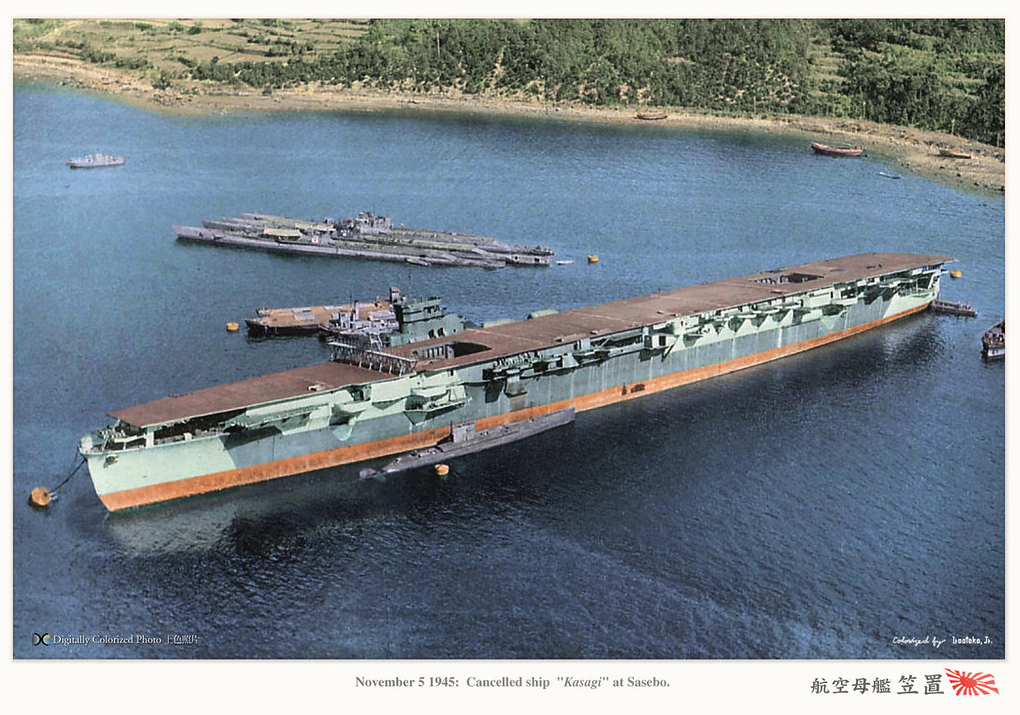
The incomplete Kasagi in Kure, September 1945 – Colorized by Irootoko Jr.
Kasagi was cancelled on 1/4/1945 at 85% completion and BU 1947. Aso and Ikoma were suspended in January, 1945, at 60% completion and their incomplete hulls already had been badly damaged by an air raid. These two were BU in 1947.
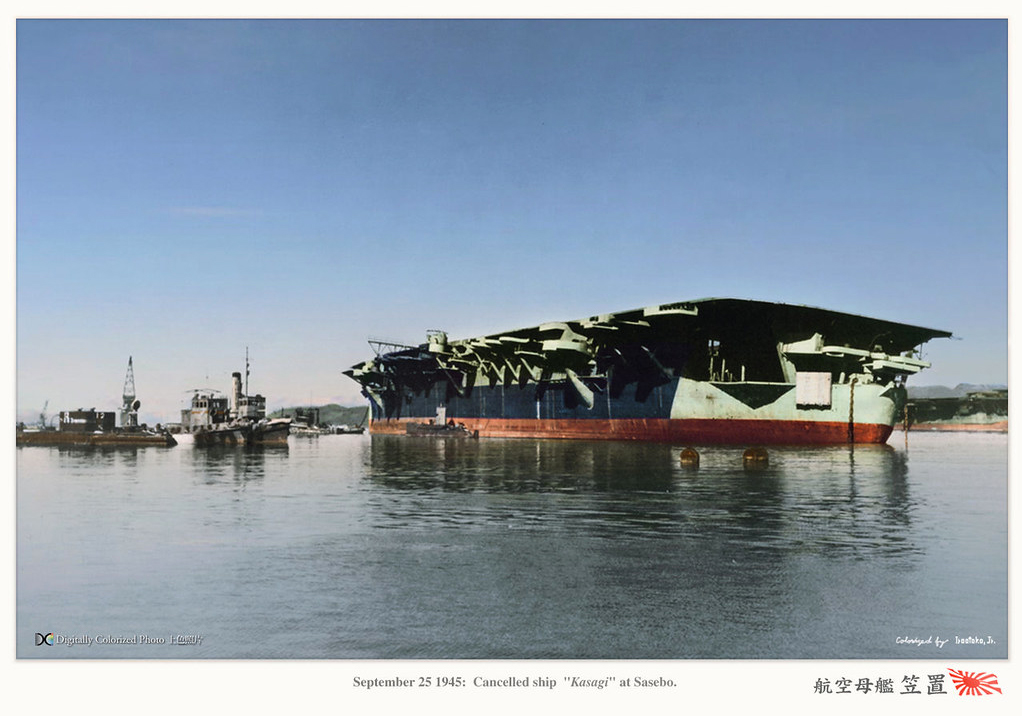
Kasagi in Sasebo, Sept. 1945

Kasagi interior photo via the lift. No photo for the following paper ships
 5002 and 5005
5002 and 5005
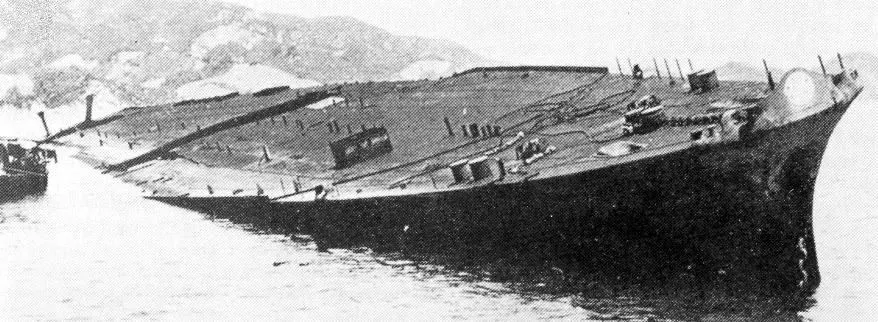
Hull of the sunken IJN Aso. No photo for the unnamed 5002-5005 as none was laid down. They were cancelled in favor of the improved Ikoma class.
Two unnamed ships, 5002 ordered from Yokosuka Naval Arsenal. None was laid down. Cancelled in 1943, materials were reused for completing the construction of IJN Shinano. Indeed, Ship Number 5002 and 5005 (built by Yokosuka Naval Arsenal) were to have been built simultaneously using Shinano’s large dock, but it was never to be as the latter was continued. They were part of the Modified Hiryū class “Kai Hiryū-gata” like the rest of the class.
 IJN Aso
IJN Aso
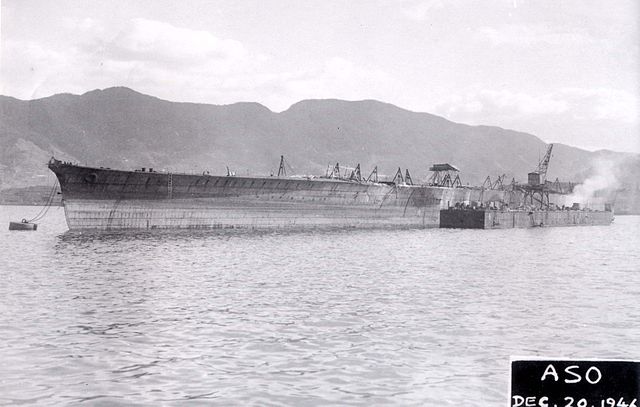
IJN Aso (5006) was laid down at Kure Naval Arsenal on 8 June 1943, launched on 1st November 1944, scheduled for completion in September 1945. She was 60% complete was construction was stopped on 9 November 1944. Her hull was damaged by air raids in July 1945. Scuttled in July 1945, she was salvaged and scrapped between 21 December 1946 and 26 April 1947.
 IJN Ikoma
IJN Ikoma

IJN Ikoma (生駒) was laid down at Kawasaki-Kobe Shipyard on 5 July 1943. She was launched on 17 November 1944, with expected completion by October 1945. However she was 60% complete when construction was stopped on 9 November 1944 due to other priorities. She remained in harbor and was eventually scrapped from 4 July 1946 to 10 March 1947.
 IJN Kurama
IJN Kurama
IJN Kurama (鞍馬) was to be laid down at Mitsubishi-Nagasaki Shipyard on November 1943, scheduled to be completed in December 1945, but she was Cancelled on 5 May 1944 without any work done. Paper project only, like the following, but at least she had a name.
 5009-5015
5009-5015
The remainder unnamed hulls of the Ikoma sub-class were all cancelled on 11 August 1943. These were the following:
#5009 (Yokosuka Naval Arsenal, expected LD July 1943, comp. March 1946 (possible name Kaimon).
#5010 (Mitsubishi-Nagasaki Shipyard) expected LD April 1944, comp. June 1946
#5011 (Yokosuka Naval Arsenal) expected LD June 1944, comp. September 1946
#5012 (Kure Naval Arsenal) expected LD June 1944, Comp. September 1946
#5013 (Yokosuka Naval Arsenal) expected LD June 1944, comp. March 1947
#5014 (Yokosuka Naval Arsenal) expected LD October 1944, comp. September 1947
#5015 (Yokosuka Naval Arsenal) expected LD January 1945, comp. March 1948
As for their names, the #5009-5015 would probably adopt (after 4 June 1943) provinces and mountains names like Asama and Tate, Aku, Kita, Yari, Fuji, Yufu, Hotaka, Aino, Yorikura, Aikaishi, Shiomi, Warusama, Yakushi, Tsurugi, Hijiri, etc.

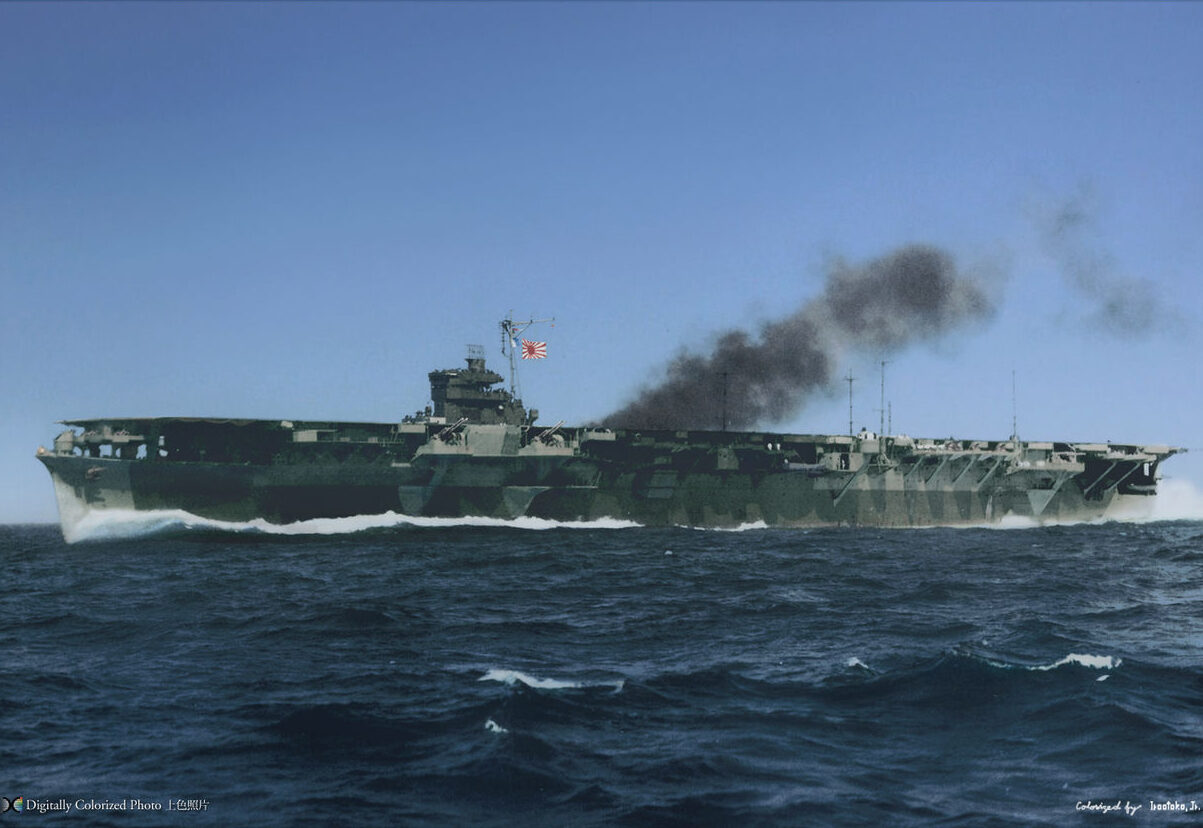
 Latest Facebook Entry -
Latest Facebook Entry -  X(Tweeter) Naval Encyclopedia's deck archive
X(Tweeter) Naval Encyclopedia's deck archive Instagram (@navalencyc)
Instagram (@navalencyc)





 French Navy
French Navy Royal Navy
Royal Navy Russian Navy
Russian Navy Armada Espanola
Armada Espanola Austrian Navy
Austrian Navy K.u.K. Kriegsmarine
K.u.K. Kriegsmarine Dansk Marine
Dansk Marine Nautiko Hellenon
Nautiko Hellenon Koninklije Marine 1870
Koninklije Marine 1870 Marinha do Brasil
Marinha do Brasil Osmanlı Donanması
Osmanlı Donanması Marina Do Peru
Marina Do Peru Marinha do Portugal
Marinha do Portugal Regia Marina 1870
Regia Marina 1870 Nihhon Kaigun 1870
Nihhon Kaigun 1870 Preußische Marine 1870
Preußische Marine 1870 Russkiy Flot 1870
Russkiy Flot 1870 Svenska marinen
Svenska marinen Søværnet
Søværnet Union Navy
Union Navy Confederate Navy
Confederate Navy Armada de Argentina
Armada de Argentina Imperial Chinese Navy
Imperial Chinese Navy Marinha do Portugal
Marinha do Portugal Mexico
Mexico Kaiserliche Marine
Kaiserliche Marine 1898 US Navy
1898 US Navy Sovietskiy Flot
Sovietskiy Flot Royal Canadian Navy
Royal Canadian Navy Royal Australian Navy
Royal Australian Navy RNZN Fleet
RNZN Fleet Chinese Navy 1937
Chinese Navy 1937 Kriegsmarine
Kriegsmarine Chilean Navy
Chilean Navy Danish Navy
Danish Navy Finnish Navy
Finnish Navy Hellenic Navy
Hellenic Navy Polish Navy
Polish Navy Romanian Navy
Romanian Navy Turkish Navy
Turkish Navy Royal Yugoslav Navy
Royal Yugoslav Navy Royal Thai Navy
Royal Thai Navy Minor Navies
Minor Navies Albania
Albania Austria
Austria Belgium
Belgium Columbia
Columbia Costa Rica
Costa Rica Cuba
Cuba Czechoslovakia
Czechoslovakia Dominican Republic
Dominican Republic Haiti
Haiti Hungary
Hungary Honduras
Honduras Estonia
Estonia Iceland
Iceland Eire
Eire Equador
Equador Iran
Iran Iraq
Iraq Latvia
Latvia Liberia
Liberia Lithuania
Lithuania Mandchukuo
Mandchukuo Morocco
Morocco Nicaragua
Nicaragua Persia
Persia San Salvador
San Salvador Sarawak
Sarawak Uruguay
Uruguay Venezuela
Venezuela Zanzibar
Zanzibar Warsaw Pact Navies
Warsaw Pact Navies Bulgaria
Bulgaria Hungary
Hungary

 Bundesmarine
Bundesmarine Dutch Navy
Dutch Navy Hellenic Navy
Hellenic Navy Marina Militare
Marina Militare Yugoslav Navy
Yugoslav Navy Chinese Navy
Chinese Navy Indian Navy
Indian Navy Indonesian Navy
Indonesian Navy JMSDF
JMSDF North Korean Navy
North Korean Navy Pakistani Navy
Pakistani Navy Philippines Navy
Philippines Navy ROKN
ROKN Rep. of Singapore Navy
Rep. of Singapore Navy Taiwanese Navy
Taiwanese Navy IDF Navy
IDF Navy Saudi Navy
Saudi Navy Royal New Zealand Navy
Royal New Zealand Navy Egyptian Navy
Egyptian Navy South African Navy
South African Navy






























 Ukrainian Navy
Ukrainian Navy dbodesign
dbodesign